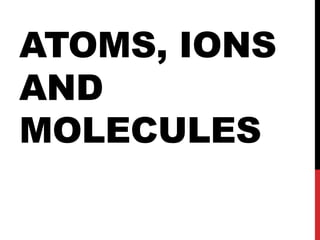Atoms, Ions and Molecules
•Als PPTX, PDF herunterladen•
4 gefällt mir•7,616 views
Melden
Teilen
Melden
Teilen

Empfohlen
Weitere ähnliche Inhalte
Was ist angesagt?
Was ist angesagt? (20)
Ähnlich wie Atoms, Ions and Molecules
Ähnlich wie Atoms, Ions and Molecules (20)
NOTES OF ELEMENTS COMPOUNDS AND MIXTURES GRADE 5.pptx

NOTES OF ELEMENTS COMPOUNDS AND MIXTURES GRADE 5.pptx
Kürzlich hochgeladen
Kürzlich hochgeladen (20)
Apidays New York 2024 - Scaling API-first by Ian Reasor and Radu Cotescu, Adobe

Apidays New York 2024 - Scaling API-first by Ian Reasor and Radu Cotescu, Adobe
DEV meet-up UiPath Document Understanding May 7 2024 Amsterdam

DEV meet-up UiPath Document Understanding May 7 2024 Amsterdam
EMPOWERMENT TECHNOLOGY GRADE 11 QUARTER 2 REVIEWER

EMPOWERMENT TECHNOLOGY GRADE 11 QUARTER 2 REVIEWER
Polkadot JAM Slides - Token2049 - By Dr. Gavin Wood

Polkadot JAM Slides - Token2049 - By Dr. Gavin Wood
How to Troubleshoot Apps for the Modern Connected Worker

How to Troubleshoot Apps for the Modern Connected Worker
Strategize a Smooth Tenant-to-tenant Migration and Copilot Takeoff

Strategize a Smooth Tenant-to-tenant Migration and Copilot Takeoff
CNIC Information System with Pakdata Cf In Pakistan

CNIC Information System with Pakdata Cf In Pakistan
"I see eyes in my soup": How Delivery Hero implemented the safety system for ...

"I see eyes in my soup": How Delivery Hero implemented the safety system for ...
Biography Of Angeliki Cooney | Senior Vice President Life Sciences | Albany, ...

Biography Of Angeliki Cooney | Senior Vice President Life Sciences | Albany, ...
Vector Search -An Introduction in Oracle Database 23ai.pptx

Vector Search -An Introduction in Oracle Database 23ai.pptx
Apidays New York 2024 - Passkeys: Developing APIs to enable passwordless auth...

Apidays New York 2024 - Passkeys: Developing APIs to enable passwordless auth...
TrustArc Webinar - Unlock the Power of AI-Driven Data Discovery

TrustArc Webinar - Unlock the Power of AI-Driven Data Discovery
Why Teams call analytics are critical to your entire business

Why Teams call analytics are critical to your entire business
Atoms, Ions and Molecules
- 2. ATOMS • There are more than 100 types of elements existing naturally in this world. • An element is a substance consisting of one type of atom only. It cannot be broken down chemically into simpler substances. • Atom of different elements are different in size. • An atom is the smallest particle of a substance. • It has a nucleus which contains protons and neutrons. • Electrons move around the nucleus in the electron shell or orbit.
- 3. ATOMS • Characteristics of the three-sub-particles of an atom:
- 4. ATOMS • An atom has equal numbers of protons and electrons. The total number of positively charged protons is neutralized by an equal number of negatively charged electrons. So, an atom is electrically neutral because there is no net charge.
- 5. PROTON AND MASS NUMBER • Proton number (or atomic number) Z is the number of protons in the nucleus of an atom. • Nucleon number (or mass number) A is the total number of proton and neutron in the nucleus of an atom. • Proton number also indicates the number of electrons in a atom. (Recall that an atom has equal number of protons and electrons)
- 6. ISOTOPES • Isotopes are atoms that have the same number of protons but different number of neutrons. • Due to the difference in the number of neutrons, isotopes have different mass number.
- 7. IONS • All atoms are electrically neutral. They have equal number of protons and electrons. • When an atom loses or gains electrons, the number of protons is not equal to the number of electrons anymore. Therefore, the atom will not be electrically neutral. • When an atom is not electrically neutral, it is called an ion. • There are two types of ions: - If an atom loses electron(s), it becomes a positive ion. - If an atom gains electron(s), it becomes a negative ion. • In the formation of ions, the process only involves the gaining or losing electrons. Therefore, electrons are responsible for chemical properties of an atom
- 8. IONS • The number of protons and neutrons remains the same. Therefore, proton number and mass number are not affected. • In the formation of ions: - Metals lose electrons to form positive ions - Non-metals gain electrons to form negative ions
- 9. FORMATION OF POSITIVE IONS • The symbol for a positive ion contains the followings: - A positive sign indicating loss of electron - A numerical number indicating number of electron being lost. X 2+
- 10. FORMATION OF NEGATIVE IONS • The symbol for a negative ion contains the followings: - A negative sign indicating gain of electron - A numerical number indicating number of electron being gained. Y 3-
- 11. MOLECULES • Molecules are two or more atoms chemically joined together. • A molecule can be made up of atoms of the same element or of different element. • A molecule which contains two atoms of the same or different type chemically joined together is called a diatomic molecule.
- 12. MOLECULE OF AN ELEMENT • A molecule of an element is a substance containing two or more of the same type of atom chemically joined together.
- 13. MOLECULE OF A COMPOUND • A molecule of a compound is a substance containing two or more of different type of atoms chemically joined together.
- 14. CHEMICAL FORMULA • A chemical formula of a substance indicates two important information about the substance: - Type of element - Total number of each type of atom